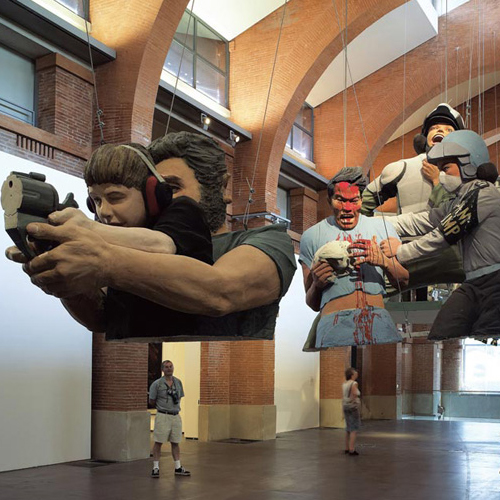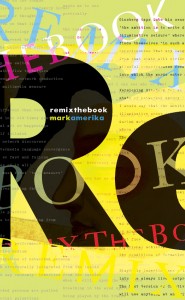
Postproduction

The term postproduction in film and television refers to the work done after principal shooting has taken place. This would include the editing, color correction, special effects, etc. In other words, it is during postproduction that the data that has been captured is cut up, moved around, filtered, and shaped into a finished work.
On the other hand, postproduction art, a term coined by Nicolas Bourriaud in his book Postproduction: Culture as Screenplay: How Art Reprograms the World, refers to specific artworks made of preexisting works. In Bourriaud’s curatorial view, the artist takes what has already been produced in culture and, through creative postproduction means, expresses a new cultural configuration that both speaks to contemporary culture as well as the source material that has been remixed. Of course, this isn’t particularly new and – as Bourriaud points out in his short book – the patron saint of contemporary postproduction practice is none other than Marcel Duchamp. In fact, in Postproduction, Bourriaud touches on a few crucial themes that are relevant to our research into interdisciplinary and multimedia forms of remix art and theory. In his short curatorial treatise, Bourriaud informs us that:
1. innovative methods of postproduction (PP) are the modus operandi of many contemporary artists, beginning with Duchamp
2. “Throughout the Eighties, the democratization of computers and the appearance of sampling allowed for the emergence of a new cultural configuration, whose emblematic figures are the programmer and DJ”
3. in addition to Duchamp, the practice of postproduction is indebted to the methods of détournement practiced by the Situationists and their offspring, not to mention the Lettrists who came before them
4. PP artists “reedit historical or ideological narratives, inserting the elements that compose them into alternative scenarios”
5. PP artists reenvision the exhibition space as “a space of cohabitation, an open stage somewhere between decor, film set, and information center.
In Postproduction, Bourriaud writes that “[n]otions of originality (being at the origin of) and even of creation (making something from nothing) are slowly blurred in this new cultural landscape marked by the twin figures of the DJ and the programmer, both of whom have the task of selecting cultural objects and inserting them into new contexts.” If we consider the high-performance attitude/mindset of a contemporary DJ or VJ artist (see Live A/V) and mash it up with the “creative writing” methods employed by software programming artists who are able to engineer the development of computer codes, the emergence of the PP artist in 21st century art and culture reveals to us just how much has changed in the last thirty years and where the future of both art and its theoretical axis is headed.
But does Bourriaud prognosticate the future forms of art and theory or is he cleverly reiterating and (metaphorically speaking) “cashing in” on a well-worn trend?
Let’s take a closer look at these five particular remixed samples numbered above. Whereas one may get a taste of where Bourriaud’s curatorial mindset was at and what his current interests at the time of writing (2002) were, it could be said that the first three samples are by now a given for most of us who have been practicing PP art over the last two decades. The fourth sample, about PP artists reediting “historical or ideological narratives, inserting the elements that compose them into alternative scenarios,” relates both to some PP art but more importantly to what we might term YouTube-Flash-App culture and the Net-roots scene that uses Web-based distribution protocols and video/animation technologies to spin a different tale about contemporary art, politics, and current events. The last sample, where he suggests “artists reenvision the exhibition space” is somewhat limited in scope and needs to take into account the potential of Net-influenced artists to radically sever themselves from the profit-driven exhibition contexts of the PP art Bourriaud celebrates, especially when viewed in relation to the over ten years of explosive development of new art forms specific to the Web, ad hoc hacker festivals, live A/V performances in fly-by-night club spaces, practice-based performances of heretofore unrealized theory works at new media festivals, etc.
The DIY trends in contemporary practice that attempt to reposition the PP artists of today as cultural figures who are not necessarily attached to the idea of “playing the art world game,” suggest a generational difference is emerging between those ready-for-the-mainstream artists Bourriaud champions in his book and the exponentially growing number of amateur culture jammers whose adherence to developing new modes of digital creativity challenge our 20th century notions of what an artist is. It ends up that devoting all of ones creative and administrative energy to the ups and downs of the upmarket, elitist, commodity art world culture, is no longer enough to sustain a focused remix practice nor is it even “a necessary evil” PP artists must open themselves up to while exploring the potential research platforms afforded by the networked and mobile media culture. Creating just-in-time ad hoc networks of feedback and support over the Internet and via underground events such as BYOB (Bring Your Own Beamer) one night exhibitions are indicative of alternative options for the PP artist to consider when collaborating with their peers on developing an emerging art scene that emanates real-world value.
These emerging scenes are signaling an eclectic mix of new trends including but not limited to:
1. an explosion of hybridized art forms emerging out of interdisciplinary media arts practices (iMAP)
2. the emergence of Net-centric or Internet-aware contemporary artists using new media technologies to both compose their art work as well as display it and/or stream it through the networked space of flows
3. the efflorescence of a lively remix culture reassessing what is and is not potential “source material” and a chops-driven “co-opetive” (as opposed to “competitive”) networking environment that spurs on a “creative arts commons” open to the shared manipulation of Source Material Everywhere where the participating artists readily repurpose or “version” their works-in-process for a wide array of media genres and platforms
4. the online performance of digitally constructed identities and/or artistically generated fictional personae composing on-the-fly meta-histories, narrative mythologies, and collaborative networks (both anonymous and pseudonymous) as strategic aspects of positioning what in remixthebook is referred to as “the artist-medium” as a creative instrument investigating what it means to remix ones “cut-and-paste as-you-go” digital practice into a larger philosophical and theoretical quest that coheres ones intense experiences into an ongoing aesthetic fact (for more discussion on the concept of an intense experience as an “aesthetic fact,” see chapter one in remixthebook, “Source Material Everywhere”)
5. a more entrepreneurial, open-mindedness to alternative distribution schemes that may enable the contemporary artist to locate audiences via electronic art and sound festivals, underground club spaces, alternative store fronts, indie DVD labels, and social media networking sites but also in combination with more traditional venues such as museums, galleries, print publications, university art centers, and recital/dance halls which then feeds into their collaborative art-research investigations into developing future models of “audience reception”
Bourriaud’s short treatise on Postproduction is essential reading for any remix artist and/or theorist in that it gets you inside the head of one of our most gifted and productive curators in the mainstream art world. Having said that, in remixthebook we offer an alternative model of writing and/or performing theory that showcases how artists are inventing new modes of postproduction as part of their own practice-based research methods investigating innovative models of theoretical discourse. Reading remixthebook in conjunction with Bourriaud’s Postproduction reveals how both the artist and the curator see the role remix culture plays in contemporary art practice but also distinguishes how developing a personal writing style as a parallel poetics can help facilitate the emergence of both contemporary curatorial and artistic practice.
An Exercise in Postproduction Art and Theory:
Exactly what does it mean to be a PP artist actively engaged in network culture, one who explores issues of persona, medium, body, instrument, and spontaneity? Addressing this question by remixing passages from both remixthebook and Postproduction (as well as Paul M. Miller’s Rhythm Science) just might enable you to reinvent the way we think about contemporary digital arts practice as well as writing remix theory too.
Find a copy of Bourriaud’s Postproduction for free on the Internet and download it. Choose twenty phrases that you think may be useful for your forthcoming remix.
Do the same thing with remixthebook and Paul M. Miller’s Rhythm Science.
Take these sixty phrases and mash-them up into a manifesto composed of twenty numbered statements.
At this point you could keep the manifesto as is, or begin expanding the project into other multi-media forms.
For example, you could take these numbered statements and plug them into a Google image search.
Choose one image from the first page of images that comes up and alter it so that it becomes your “own.”
Use the original “remix” statement you plugged in to the Google image search as a caption or subtitle and create a new series of artworks out of this procedural remix composition.
Another alternative would be to record a voice (or sequence of voices) reading these statements and then later using these recordings as a voiceover for a video art “mockumentary” about the contemporary state of remix culture and contemporary art.
Questions for discussion:
1. In remixthebook, Amerika samples heavily from artists such as Duchamp, Paik, Ginsberg, Acker, and others, to expand on his concept of the artist as a postproduction medium. Discuss other artists who may fit into this label. What about your own practice and/or theory? Are you too the kind of postproduction medium that Amerika is modeling in remixthebook?
2. Is there still a place for museum and gallery culture in the age of digital postproduction and distribution? Why or why not?
3. Describe a future form of postproduction art that does not exist today but that you can imagine twenty years from now. As you describe this future art form, try and go way out, into “your own poetry universe” (as Ginsberg says), and project an image of artistic practice that would sit well in a sci-fi novel.
Related Images
Postproduction Links
- Rebirth of a Nation – DJ Spooky
- 24 Hour Psycho Manipulated Time Heals All Wounds
- Synthetic Performances There’s always a Second Life
- CNN Concatenated Anchordroid Death Rap
- Velvet Strike Online Peaceniks Subvert Mainstream Adolescence
- Martin Arnold Alone. Life Wastes Andy Hardy
- Bjorn Melhus Postproduction Art has a name and it is Bjorn Melhus
- Glenlandia Pixel Harvesting the Landscape
- Remixing God Giselle Beiguelman remixes Mark Amerika (and Herself)
- Mark Amerika Lecture Remix Composed by Will Luers
- Cory Arcangel Super Mario Clouds











